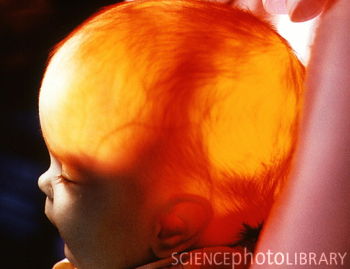美国科学家9月7日报告说,他们用小鼠进行的试验发现,胎儿脑积水可能是一种叫做溶血磷脂酸的物质过量所致。这项发现或有助于胎儿脑积水的诊断和治疗。

胎儿脑积水是一种由脑脊液过多积聚于脑室系统导致的神经管畸形,会导致新生儿脑损伤、头部异常大,可能致死。目前的治疗手段主要是通过手术植入分流装置,帮助积水排出,但长期效果不理想。
人们此前曾发现脑积水与颅内出血有关,但不清楚具体原理。美国斯克里普斯研究所的科学家发现,血液中的一种正常成分——溶血磷脂酸(LPA)可能是问题的关键。
试验发现,给小鼠胚胎脑室注射溶血磷脂酸,能引发类似人类胎儿脑积水的病征;但如果事先注射一种化合物,阻止溶血磷脂酸与脑细胞表面的受体分子结合,再注射溶血磷脂酸就不会引发脑积水。
研究人员表示,“这就好比过度用药”。溶血磷脂酸是血清的正常成分,由血小板、成纤维细胞、脂肪细胞分泌,是一种具有多种生物学功能的信号分子,对神经元及其他细胞发育起到重要作用。如果溶血磷脂酸过量,脑细胞表面受体分子的活动就会出现异常,导致胎儿大脑在形成过程中结构发生变化,一些细胞的位置也会发生异常变动,其中包括帮助控制液体流动的细胞,最终导致脑积水。
这项研究成果7日发表在美国新一期《科学—转化医学》杂志上。研究人员表示,还需要做进一步的研究以确认溶血磷脂酸在人体中是否起同样作用。
生物探索推荐英文论文摘要:
Fetal hydrocephalus (FH), characterized by the accumulation of cerebrospinal fluid, an enlarged head, and neurological dysfunction,is one of the most common neurological disorders of newborns. Although the etiology of FH remains unclear, it is associatedwith intracranial hemorrhage. Here, we report that lysophosphatidic acid (LPA), a blood-borne lipid that activates signalingthrough heterotrimeric guanosine 5′-triphosphate–binding protein (G protein)–coupled receptors, provides a molecular explanationfor FH associated with hemorrhage. A mouse model of intracranial hemorrhage in which the brains of mouse embryos were exposedto blood or LPA resulted in development of FH. FH development was dependent on the expression of the LPA1 receptor by neural progenitor cells. Administration of an LPA1 receptor antagonist blocked development of FH. These findings implicate the LPA signaling pathway in the etiology of FH andsuggest new potential targets for developing new treatments for FH.







